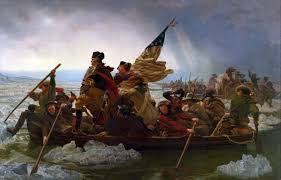Introduction
Art plays a central role in the advancement of societies by passing experiences from one generation to another, instilling values, and shaping opinions toward the collective progress of humankind. In other words, art is a vehicle for social change, which allows generations from different cultures and times to communicate with each other through various forms, such as paintings, sculptures, literature, and music among others. From the Renaissance through Baroque, Neoclassicism, Romanticism, to contemporary movements, each art era has distinguishing features based on the underlying themes addressing relevant issues at the time. This paper analyses Giotto’s Madonna Enthroned from the Renaissance and Emanuel Leutze’s Washington Crossing the Delaware from the Romanticism movement.
Madonna Enthroned
Madonna Enthroned also known as Virgin and Child Enthroned (Ognissanti Maestà) is a painting by Giotto (Vespignano, Vicchio di Mugello) using the tempera on wood technique between 1300 and 1305. It was created in Italy and it belongs to the Early Renaissance Movement. In the painting, Virgin Mary is seated on a throne while holding baby Jesus in her arms – a view that elicits the image of a queen seated on a throne. This iconography births the title Maestà, which is the Italian word for Majesty. The Virgin, who is the ceremonial Queen of Heaven, holds a baby on her lap surrounded by angels. The baby’s right hand is raised as a sign of giving blessing while his left hand holds a scroll to symbolize knowledge. The throne is surrounded by a multicolored tabernacle, which is reminiscent of Gothic Architecture that was popular during this time.
This painting was highly influenced by the concept of humanism as an emergent ideology during the Renaissance characterized by intense inventiveness and revived interest in literature and learning. The focus during this era was on human beings, their endeavors, responsibilities, and the quest for the common good. Humanism, according to Sachant et al., is “the belief that people are naturally good and that problems can be solved using reason instead of religion” (128).
This assertion explains why the focus in this painting is on the Virgin, who is depicted as a queen, a Madonna, as a way of giving her human embodiment. During the Middle Ages, religion defined the Sacred Culture, which in turn shaped the way of thinking and life (Yu 452). However, artists during the Renaissance sought a rebirth, and this aspect explains Giotto’s attempt to incorporate elements of humanism in this painting by portraying the Virgin as a queen. Similarly, baby Jesus holds a scroll in his left hand to symbolize knowledge – a central issue during the 14th century. As mentioned earlier, the belief that reason, as opposed to religion, could be used to solve life’s problems was hinged on the quest to pursue knowledge and celebration of human intellectual and creative accomplishments.

Washington Crossing the Delaware
Washington Crossing the Delaware is an oil on canvas painting by Emanuel Leutze in 1851 in New York and it belongs to the Romanticism movement. In the painting, George Washington is standing on a rowboat with the bright morning light illuminating his face to capture the underlying determination and heroism. Behind him are armed individuals drawn from various American colonies as a show of the revolutionary cause and strength in pursuit of a common goal of liberation. The colors used in the painting are mostly dark with a few red highlights. The people in the boat are diverse including two farmers, a rower, western rifleman, an African, a man in a Scottish bonnet, and a Native American at the back to underscore the diversity of the American colonies and the unity that they embodied as they sought freedom from their colonial masters.
This painting captures Washington’s daring attack in December 1776 when he crossed the Delaware River to invade a Hessian garrison in Trenton, New Jersey. By creating this painting in 1851, almost 75 years later after Washington’s attack, Leutze wanted to inspire liberal reformers to continue fighting for their course during the European Revolutions of 1848. According to Merriman, the European Revolutions were liberal in nature with the objective of dethroning monarchical structures across Europe and replacing them with independent states (715). Therefore, Leutze, inspired by Romanticism – the intellectual and artistic movement that was a product of the Enlightenment seeking freedom for all mankind, hoped that reformers of his time would borrow from Washington’s bravery and continue to agitate for independence.
As such, it suffices to argue that the central theme in this painting is Washington’s courage and resolve to fight for freedom. The unity toward a common course of liberation as depicted by the diversity of the people on the boat was also meant to inspire all Europeans to come together and fight for their freedom. Leutze thus hoped that the patriotic pride of the American people as portrayed in the painting would significantly add to the European Revolutions, which were ongoing at the time of creating this piece of art. This assertion fits well into the Romanticism movement and the Enlightenment, which were the major influencing factors from where Leutze drew his ideas.

Works Cited
Merriman, John. A History of Modern Europe: From the French Revolution to the Present. W.W. Norton & Company, 1996.
Sachant, Pamela. Introduction to Art: Design, Context, and Meaning. University of North Georgia, 2016.
Yu, Jenny. “The Influence of Renaissance and Religious Reform on the Development of Music and Art Style.” International Conference on Humanities and Social Science 2016. Atlantis Press, 2016, pp. 452-456.